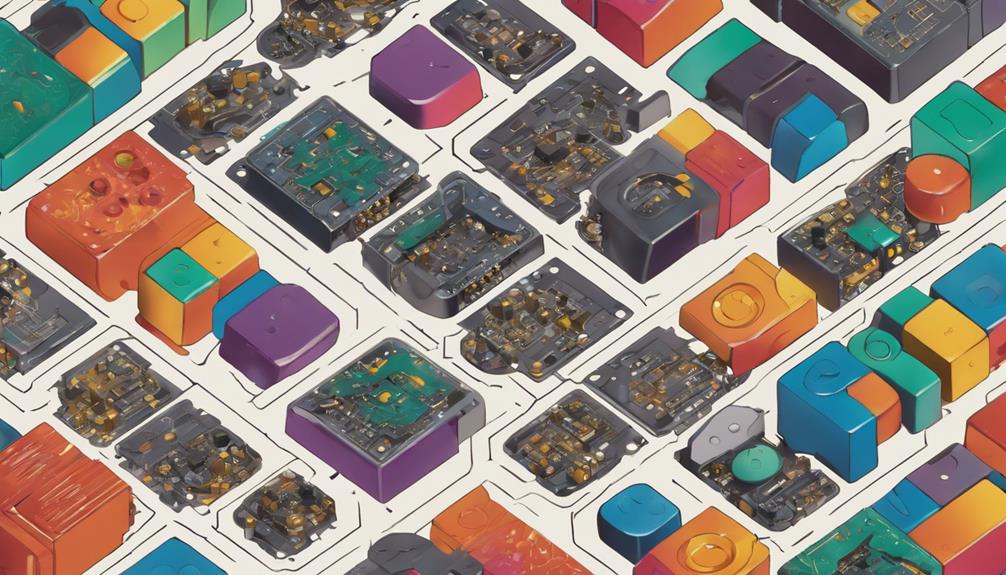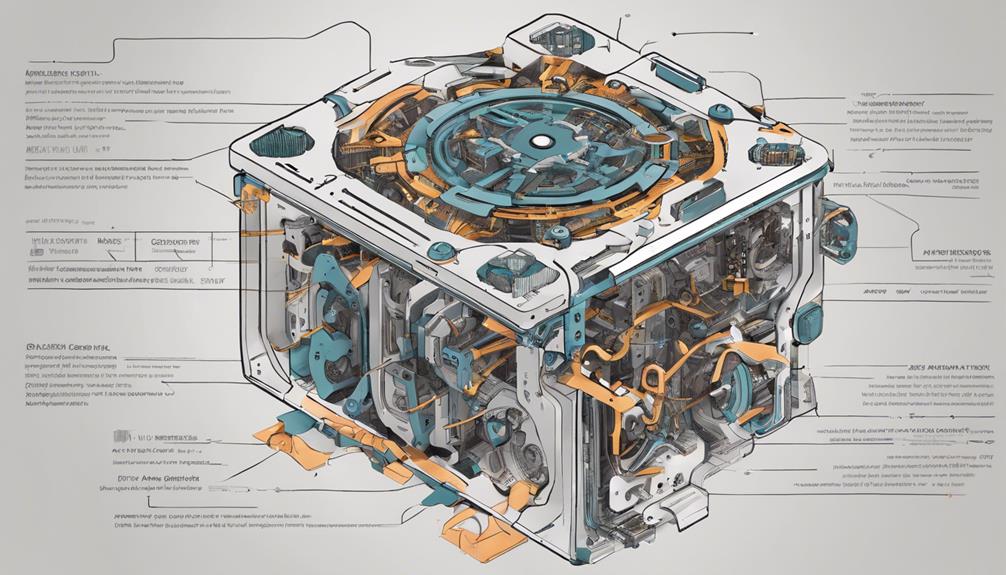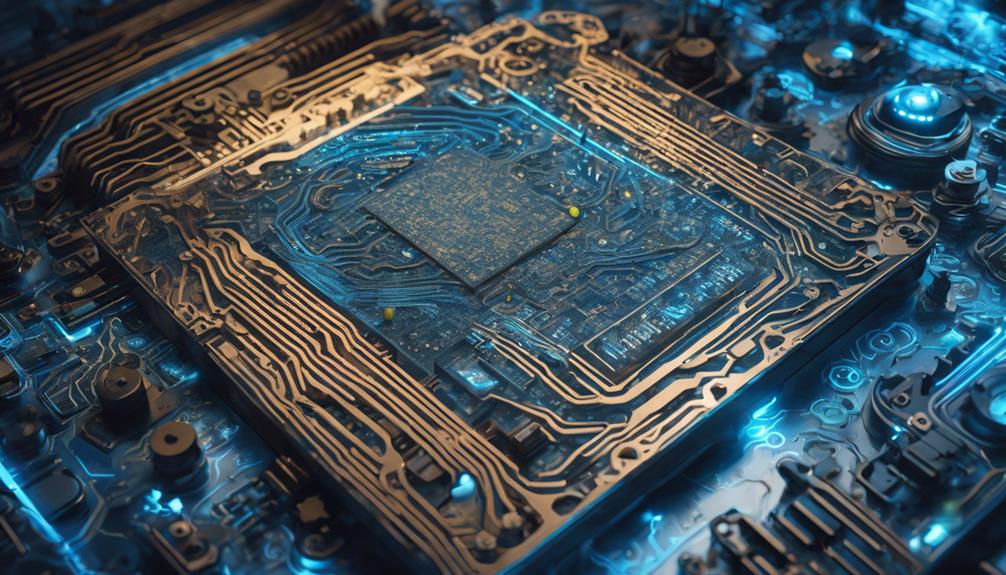Effective component obsolescence mitigation requires a proactive and structured approach. Prioritize long-term availability components, maintain regulatory compliance, and implement modular design strategies to minimize obsolescence risks. Standardize component selection processes, design for upgradability and flexibility, and monitor component lifecycles closely. Develop risk management contingency plans, prioritize component sourcing strategies, and conduct regular obsolescence audits to identify and mitigate risks. By adopting these best practices, organizations can minimize supply chain disruptions and guarantee product continuity. Continuing to explore these strategies can provide a thorough understanding of obsolescence mitigation and its applications.
Key Takeaways
- Specify long-term availability components to reduce obsolescence likelihood and ensure product continuity.
- Conduct regular obsolescence audits to proactively identify risks and implement swift mitigation strategies.
- Implement modular design strategies to enable easy upgrades and scalability, minimizing production disruptions.
- Standardize component selection processes to prioritize long-term availability and compatibility, ensuring product safety and performance.
- Partner with supply chain experts to utilize in-depth vendor relationships, implement global sourcing strategies, and enhance operational performance.
Specify Long-Term Availability Components
By prioritizing components with a proven track record of long-term availability, manufacturers can greatly reduce the likelihood of component obsolescence and its attendant redesign and supply chain disruptions. This approach is a cornerstone of a proactive obsolescence management strategy, guaranteeing product continuity and minimizing the need for costly redesigns.
Long-term availability components offer stability in supply chains by mitigating the impact of frequent part turnovers, thereby reducing operational disruptions. By specifying these components, manufacturers can align with sustainable product lifecycles and reduce the risk of obsolescence. This approach is particularly critical in industries where product longevity is paramount, such as aerospace, automotive, and industrial automation.
Maintain Regulatory Compliance Always

A manufacturer's obsolescence management strategy must incorporate a rigorous commitment to regulatory compliance, as adherence to standards like IEC 62402 is vital for mitigating component obsolescence risks and avoiding costly disruptions. Regulatory compliance is essential in ensuring that obsolescence management strategies are effective and aligned with industry standards.
To maintain regulatory compliance, manufacturers should:
- Conduct regular impact assessments to identify potential obsolescence risks and develop strategies to mitigate them.
- Stay updated on industry standards, such as IEC 62402, to guarantee adherence to compliance obligations.
- Implement a structured approach to managing component obsolescence risks, guided by regulatory frameworks.
Implement Modular Design Strategies

Implementing modular design strategies is vital for mitigating component obsolescence. It begins with designing for flexibility, standardizing component interfaces, and enabling easy upgrades. By adopting these principles, designers can create systems that can adapt to changing component availability and technological advancements.
Design for Flexibility
Modular design strategies involve breaking down complex systems into interchangeable modules. This enables designers to future-proof their products against component obsolescence by facilitating seamless upgrades and replacements. This approach is essential in component obsolescence management, as it allows for easy integration of new components and technologies, thereby extending product longevity.
By adopting modular design principles, designers can minimize production disruptions and redesign costs associated with component obsolescence. This flexibility in design also enables efficient maintenance and future-proofing against component discontinuations.
Key benefits of modular design strategies include:
- Easy component replacement and upgrades, reducing the risk of production disruptions.
- Swift adaptation to new technologies, enabling designers to stay ahead of the curve.
- Reduced redesign costs, minimizing the financial impact of component obsolescence.
Standardize Component Interfaces
By standardizing component interfaces, designers can guarantee seamless integration of new components and reduce the complexity associated with component obsolescence. Implementing modular design strategies enables the standardization of component interfaces, allowing for easy replacement and upgrades. This approach reduces redesign efforts and costs when facing component obsolescence. Modular designs enable quick and efficient integration of new components without requiring major system changes, ensuring minimal disruption to product functionality.
Standardized interfaces improve interoperability and compatibility across different components, enhancing overall system flexibility. This design approach also future-proofs products against component obsolescence risks, reducing the likelihood of costly redesigns or replacements. By adopting modular design practices, designers can secure that their products remain adaptable and resilient in the face of component obsolescence.
Enable Easy Upgrades
One effective way to future-proof products against component obsolescence is to enable easy upgrades through the strategic implementation of modular design strategies. By adopting a modular approach, manufacturers can create upgradable modules that can be easily replaced or updated as new technologies emerge, thereby extending the lifespan of a product.
Here are three key benefits of implementing modular design strategies:
- Reduced impact of component obsolescence:
Modular designs minimize the impact of component obsolescence on the overall product lifecycle, allowing for quick response to end-of-life components and ensuring continuity of operations.
- Easy adaptation to technological advancements:
Modular approaches enhance flexibility in adapting to changing market demands and technological advancements, enabling manufacturers to stay ahead of the curve.
- Extended product lifespan:
Upgradable modules can extend the lifespan of a product by accommodating new technologies without redesigning the entire system, reducing the need for costly redesigns and retooling.
Standardize Component Selection Process

To minimize the risk of component obsolescence, a standardized process for selecting components is crucial, as it enables companies to prioritize long-term availability and compatibility. This process guarantees that components are chosen based on industry standards and guidelines, ensuring compatibility and longevity in products. By implementing standardized criteria for selecting components, companies can streamline the design process and minimize future supply chain disruptions.
| Criteria | Industry Standard | Benefits |
|---|---|---|
| Component Selection | IEEE, IPC, JEDEC | Secures compatibility and longevity |
| Supply Chain Management | ISO 28000 | Minimizes supply chain disruptions |
| Product Design | IEC, UL, CE | Secures product safety and performance |
Design for Upgradability and Flexibility

Designing for upgradability and flexibility is essential in mitigating component obsolescence. This can be achieved through the implementation of modular component design. It enables the effortless replacement of outdated components with minimal system disruption.
A design for scalability guarantees that systems can adapt to evolving requirements and accommodate new technologies seamlessly. By incorporating future-proof architecture, manufacturers can guarantee that their products remain relevant and functional despite the rapid pace of technological advancements.
Modular Component Design
By incorporating modular component design principles, systems can be engineered to accommodate future upgrades and replacements, thereby minimizing the risks associated with component obsolescence. This approach enables the creation of flexible and adaptable systems that can be easily modified to accommodate emerging technologies, extending product lifespan and promoting sustainability.
Modular component design offers several benefits, including:
- Easy upgrades and replacements: Individual components can be swapped out or upgraded without affecting the entire system, reducing downtime and minimizing the impact of component obsolescence.
- Improved sustainability: Modular design promotes reuse and recycling of components, reducing electronic waste and supporting environmentally friendly practices.
- Enhanced flexibility: Modular systems can be quickly adapted to meet changing market demands and component availability, ensuring continued system functionality and minimizing the risks associated with component obsolescence.
Design for Scalability
Building on the principles of modular component design, a scalable system architecture can be achieved by incorporating design features that facilitate seamless upgrades and modifications. This ensures continued functionality and minimizes the risks associated with component obsolescence.
Designing for scalability involves creating products that can easily accommodate upgrades and modifications to extend their lifespan. This flexibility in design allows for future component replacements and technology advancements without major redesign efforts. Scalable designs reduce the impact of component obsolescence by enabling seamless integration of new parts.
Upgradability features in product design support longer product lifecycles and reduce the frequency of redesigns. By incorporating flexibility in design, manufacturers can mitigate risks associated with component obsolescence and ensure adaptability to changing market demands. This approach enables products to stay relevant and competitive, even as technology evolves and market demands shift.
Future-Proof Architecture
As technology continues to evolve at an unprecedented pace, incorporating future-proof architecture into system design becomes crucial to mitigate the risks associated with component obsolescence. A future-proof architecture guarantees that systems are designed with flexibility and upgradability in mind, allowing for seamless integration of new technologies and components as they emerge.
To achieve this, designers can employ the following strategies:
- Modular design: Break down complex systems into smaller, independent modules that can be easily replaced or upgraded without affecting the entire system.
- Design for upgradability: Plan for future upgrades by designing systems that can accommodate new components and technologies with minimal disruption.
- Flexibility in architecture: Build systems that can adapt to changing market demands and technological advancements, reducing the impact of component obsolescence.
Partner With Supply Chain Experts

Collaborating with supply chain experts, who possess in-depth knowledge of vendor relationships and global sourcing strategies, can greatly enhance an organization's ability to mitigate component obsolescence.
By partnering with these experts, organizations can leverage their expertise to optimize inventory levels and decision-making support, thereby reducing the risk of component obsolescence.
Strategic partnerships with supply chain experts can help address component obsolescence challenges effectively, enhancing supply chain resilience and efficiency.
These experts can provide guidance on vendor relationships and global sourcing strategies, mitigating supply chain disruptions and streamlining inventory management processes. This, in turn, improves operational performance and reduces the likelihood of component obsolescence.
Monitor Component Lifecycles Closely

Proactively monitoring component lifecycles is essential for identifying potential obsolescence risks before they disrupt production, allowing organizations to respond promptly to end-of-life notifications and mitigate supply chain disruptions.
To effectively monitor component lifecycles, organizations can utilize the following strategies:
- Track component lifecycle statuses using tools like SiliconExpert to receive alerts on end-of-life notifications.
- Regularly review product lifecycle reports and manufacturer updates to stay informed on component availability.
- Establish a structured approach to monitoring component lifecycles, ensuring timely responses to end-of-life notifications.
Develop Risk Management Contingency Plans

A comprehensive risk management contingency plan is essential to mitigate the impact of component obsolescence on production timelines and costs, ensuring business continuity and minimizing revenue losses. This plan should address risks such as component shortages, production disruptions, and increased costs.
To develop an effective contingency plan, it is important to identify critical components, assess risks, and create alternative sourcing strategies. Proactively engaging with suppliers, monitoring market trends, and maintaining a buffer inventory can also help mitigate the impact of component obsolescence.
Regularly reviewing and updating contingency plans is crucial to adapt to changing market conditions. By doing so, companies can reduce the impact of component obsolescence on production timelines and costs.
A well-structured contingency plan enables companies to respond quickly and effectively to component shortages, ensuring business continuity and minimizing revenue losses. By integrating risk management into their component sourcing strategy, companies can ensure a more resilient supply chain.
Prioritize Component Sourcing Strategies

To minimize the risks associated with component obsolescence, companies must prioritize component sourcing strategies that guarantee a stable supply of critical components throughout the product lifecycle. This involves implementing strategic sourcing strategies that align with product lifecycle and market demands.
To achieve this, companies can:
- Verify component availability: Utilize component databases to verify the lifecycle status and availability of components, ensuring that sourced components are long-term available.
- Establish reliable supply chains: Develop relationships with reliable suppliers to ensure consistent component availability and minimize supply chain disruptions.
- Diversify sourcing options: Develop secondary sourcing options to mitigate disruptions caused by component obsolescence, securing a stable supply of critical components.
Conduct Regular Obsolescence Audits

Conducting regular obsolescence audits is vital for identifying components at risk of becoming obsolete. A well-defined audit scope and frequency are essential in pinpointing high-risk components and prioritizing mitigation efforts.
Audit Scope and Frequency
Regular audits are vital for proactively identifying components at risk of obsolescence and enabling timely mitigation strategies. To guarantee effective audits, it's important to define a thorough audit scope and frequency.
The audit scope should encompass all critical components and suppliers in your supply chain, including those that are nearing end-of-life status. This can be achieved by auditing your Bill of Materials (BOM) regularly.
In terms of frequency, industry standards recommend conducting obsolescence audits at least annually to stay ahead of potential risks. This allows for proactive mitigation strategies to be implemented before components become obsolete.
Here are three key considerations for audit scope and frequency:
- Thorough scope: Include all critical components and suppliers in your supply chain.
- Regular frequency: Conduct audits at least annually to stay ahead of potential risks.
- Proactive approach: Identify components at risk of obsolescence and enable timely mitigation strategies.
Identify High-Risk Components
Vigilant monitoring of component lifecycles through regular obsolescence audits enables the swift identification of high-risk components, facilitating proactive mitigation strategies to prevent supply chain disruptions.
Conducting regular audits allows for thorough analysis to pinpoint components with limited availability or manufacturer support, thereby identifying potential high-risk components. This proactive approach enables the updating of component lifecycle data, ensuring accurate forecasting and mitigation planning.
High-risk components can have devastating effects on production, leading to costly redesigns if not addressed promptly. By identifying these components early, strategic sourcing and inventory management can be implemented to mitigate obsolescence risks.
Regular audits provide a deep understanding of the component lifecycle, enabling the development of effective strategies to mitigate obsolescence. By staying ahead of component obsolescence, organizations can minimize supply chain disruptions, reduce costs, and maintain production continuity.
Through regular audits, high-risk components can be identified, and proactive measures can be taken to mitigate obsolescence, ensuring business continuity and minimizing the risk of costly redesigns.
Frequently Asked Questions
How to Minimize Obsolescence?
Minimizing obsolescence is akin to steering through a treacherous sea, where component unavailability lurks beneath the surface. To map a safe course, it is crucial to employ proactive strategies.
Implementing robust component lifecycle management, maintaining open communication with manufacturers, and analyzing product lifecycles enable informed decision-making.
Which Technique Is Used to Control Obsolescence?
To control obsolescence, a proactive approach is essential. Implementing robust supplier relationships and communication channels enables effective obsolescence management.
Utilizing component databases and obsolescence management tools enhances control over component lifecycle. Early engagement with manufacturers and suppliers facilitates timely mitigation strategies, such as last-time buys, alternate sourcing, and redesigns.
These techniques help minimize the impact of component obsolescence, ensuring continuity and reliability in product development.
How to Manage Product Obsolescence?
Managing product obsolescence demands a vital approach, where anticipation supersedes reaction.
Rather than merely responding to component unavailability, organizations must adopt a strategic mindset, leveraging component databases and manufacturer communication to forecast lifecycle challenges.
By maintaining critical component inventories and developing secondary strategies, businesses can mitigate disruptions and guarantee uninterrupted production.
Effective communication between procurement, engineering, and supply chain teams is essential in this endeavor, enabling swift adaptation to component obsolescence.
How Do You Mitigate Risk of Obsolescence?
To mitigate the risk of obsolescence, proactive measures are essential. Regularly monitor component lifecycles and maintain open communication with manufacturers to stay informed about potential risks.
Utilize component databases to identify at-risk components and develop secondary sourcing strategies to mitigate supply chain disruptions.
Analyze product lifecycle and demand volume to plan effectively, ensuring business continuity and minimizing the impact of obsolescence.


